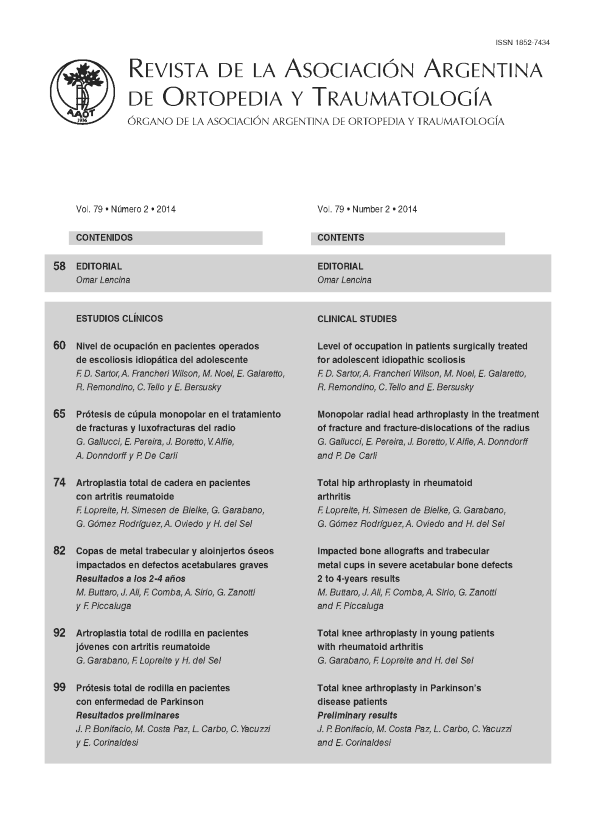Desarrollo de un simulador de bajo costo para la adquisición de destrezas básicas en cirugía artroscópica. [Development of a low-cost simulator to acquire basic arthroscopic skills.]
Contenido principal del artículo
Resumen
Descargas
Métricas
Detalles del artículo

Esta obra está bajo licencia internacional Creative Commons Reconocimiento-NoComercial-CompartirIgual 4.0.
La aceptación del manuscrito por parte de la revista implica la no presentación simultánea a otras revistas u órganos editoriales. La RAAOT se encuentra bajo la licencia Creative Commons 4.0. Atribución-NoComercial-CompartirIgual (http://creativecommons.org/licenses/by-nc-sa/4.0/deed.es). Se puede compartir, copiar, distribuir, alterar, transformar, generar una obra derivada, ejecutar y comunicar públicamente la obra, siempre que: a) se cite la autoría y la fuente original de su publicación (revista, editorial y URL de la obra); b) no se usen para fines comerciales; c) se mantengan los mismos términos de la licencia.
En caso de que el manuscrito sea aprobado para su próxima publicación, los autores conservan los derechos de autor y cederán a la revista los derechos de la publicación, edición, reproducción, distribución, exhibición y comunicación a nivel nacional e internacional en las diferentes bases de datos, repositorios y portales.
Se deja constancia que el referido artículo es inédito y que no está en espera de impresión en alguna otra publicación nacional o extranjera.
Por la presente, acepta/n las modificaciones que sean necesarias, sugeridas en la revisión por los pares (referato), para adaptar el trabajo al estilo y modalidad de publicación de la Revista.
Citas
2. Hodgins JL, Veillette C. Arthroscopic proficiency: methods in evaluating competency. BMC Med Educ 2013;13:61.
3. Camacho FJ, Herrera DP, Peralta MC, Rodríguez GP, Cortés M, Alonso GO, et al. Estandarización de un nuevo método de
entrenamiento para la adquisición de habilidades en cirugía endoscópica mediante el empleo de simuladores. Rev Méd Unisanitas
2010;13(1):40-5.
4. Camacho FJ, Ramírez JF, Herrera DP, Cortés DM. Curso Básico de Entrenamiento en Habilidades para Cirugía Endoscópica:
grado de satisfacción de los profesionales en formación. Rev Col Or Tra 2009;23:16-20.
5. Rodríguez-García J, Turienzo-Santos E. Formación quirúrgica con simuladores en centros de entrenamiento. Cir Esp
2006;79(6):342-8.
6. Jones DB. Video trainers, simulation and virtual reality. Asian J Surg 2007;30(1):6-12.
7. Kohn L. To Err is Human. Building a Safer Health System. Washington, D.C.: National Academies Press; 1999.
8. Bridges M, Diamond DL. The financial impact of teaching surgical residents in the operating room. Am J Surg 1999;177(1):28-
32.
9. Karam MD, Pedowitz RA, Natividad H, Murray J, Marsh JL. Current and future use of surgical skills training laboratories in
orthopaedic resident education: a national survey. J Bone Joint Surg Am 2013;95(1):e4.
10. Dubrowski A, Backstein D. The contributions of kinesiology to surgical education. J Bone Joint Surg Am 2004;86(12):2778-81.
11. Peyton JW, Allery L. The learning cycle. En: Peyton JW (ed.) Teaching & Learning in Medical Practice. Guildford: Manticore
Europe Limited; 1998.
12. Lake FR, Hamdorf JM. Teaching on the run tips 5: teaching a skill. Med J Aust 2004;181(6):327-8.
13. Kitson J, Blake SM. A model for developing psychomotor skills in arthroscopic knot tying. Ann R Coll Surg Engl 2006;88:501-
5.
14. Andersen C, Winding TN, Vesterby MS. Development of simulated arthroscopic skills. Acta Orthop 2011;82(1):90-5.
15. Schout BM, Hendrikx AJ, Scheele F, Bemelmans BL, Scherpbier AJ. Validation and implementation of surgical simulators: a
critical review of present, past, and future. Surg Endosc 2010;24(3):536-46.
16. Butler A, Olson T, Koehler R, Nicandri G. Do the skills acquired by novice surgeons using anatomic dry model transfer
effectively to the task of diagnostic knee arthroscopy performed on cadaveric specimens? J Bone Joint Surg Am 2013;15(1):1-8.
17. Cerrolaza M, Miquilarena R, Urbina B, Prado A, Navas H. Realidad virtual para entrenamiento en cirugía laparoscópica.
Rev Venez Cir 2006;59(2):2-4.
18. Pedowitz RA, Esch J, Snyder S. Evaluation of a virtual reality simulator for arthroscopy skills development. Arthroscopy
2002;18(6):e29.
19. Hasson HM, Kumari N V, Eekhout J. Training simulator for developing laparoscopic skills. JSLS 2001;5(3):255-65.
20. Howells NR, Brinsden MD, Gill RS, Carr AJ, Rees JL. Motion analysis: a validated method for showing skill levels in
arthroscopy. Arthroscopy 2008;24(3):335-42.
21. Martín S, María M. Formación y adiestramiento en traumatología y cirugía ortopédica. Rev Esp Cir Osteoart 2007;42(232):139-
80.

